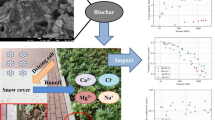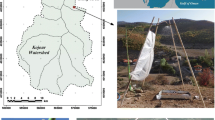Abstract
In this study, the use of a new system made of natural wood absorbers (Salix viminalis) is proposed as a tool to protect plants, groundwater and soil from the adverse effects of de-icing salt. The toxic effects of road de-icing salt on soils, groundwater and plant growth have concerned environmental scientists, especially ecologists, for decades and have already been the subject of many studies. In terms of both time and cost, sodium chloride is widely regarded as the most effective chemical for de-icing roads and pavements. The protection of roadside plants is mainly achieved by using physical barriers with a limited capacity to retain road salt. Willow chips were packed into three systems: separated micro-columns, separated micro-columns with retention cups, and a monolayer column. Each system eliminated some of the salt from a brine solution such that only low-salinity water penetrated into the soil. The efficiency of road salt uptake varied from 31–95% depending on the system. The efficiency of the system was determined based on the salt content measured in the absorber collected after winter. Soil contamination by de-icing salt and the migration of different ions in groundwater were beyond the scope of this study.






Similar content being viewed by others
References
Akhter J, Mahmood K, Malik KA, Mardan A, Ahmad M, Iqbal MM (2004) Effects of hydrogel amendment on water storage of sandy loam and loam soils and seedlings growth of barley, wheat and chickpea. Plant Soil Environ 50:463–469
Amundsen CE, Håland S, French H et al (2010) Salt SMART environmental damages caused by road salt–a literature review. Technology Department. Report. 2587
Bryson GM, Barker AV (2002) Sodium accumulation in soils and plants along Massachusetts roadsides. Commun Soil Sci Plant Anal 33:67–78
Cappiello D (2008) Report: EPA failing to stop sprawl runoff. The Seattle Times. IOP Publishing SeattleTimes
https://www.seattletimes.com/seattle-news/report-epa-failing-to-stop-sprawl-runoff/ Accessed 03 Jan 2019
Cochard H, Tyree MT (1990) Xylem dysfunction in Quercus—vessel sizes, tyloses, cavitation and seasonal changes in embolism. Tree Physiol 6:393–407
Cunningham MA, Snyder E, Yonkin D et al (2008) Accumulation of deicing salts in soils in an urban environment. Urban Ecosyst 11:17. doi:https://doi.org/10.1007/s11252-007-0031-x
Czerniawska-Kusza I, Kusza G, Dużyński M (2004) Effect of deicing salts on urban soils and health status of roadside trees in the Opole region. Environ Toxicol 19:296–301
Davies J (2017) The business case for soil. Nature 543(7645):309–311. https://doi.org/10.1038/543309a
Dittman GL (1977) Calculation of brine properties. Lawrence Livermore Laboratories 17406
Freundlich HMF (1906) Über die Adsorption in Lösungen (Adsorption in solutions). Z Phys Chem 57:385–470
Godwin KS, Hafner SD, Buff MF (2003) Long-term trends in sodium and chloride in the Mohawk River, New York: the effect of fifty years of road-salt application. Environ Poll 124:273–281
Hawkins RH (1971) Street salting and water quality in Meadowbrook, Syracuse, NY. In: Hawkins RH (ed) Proceedings: street salting, urban water quality workshop. State University College of Forestry, Syracuse, pp 62–69
Highways Agency Annual Report and Accounts (2012) IOP Publishing assets.publishing.service. https://assets.publishing.service.gov.uk/government/uploads/system/uploads/attachment_data/file/229196/0258.pdf. Accessed 08 Jan 2019
Howard K, Haynes J (1993) Groundwater contamination due to road de-icing chemicals—salt balance implications. Geosci Can 20:1–8
Hvass N (1985) Defending street trees against road salt in Denmark. JOA 11:61–64
Jackson RB, Jobbágy EG (2005) From icy roads to salty streams. Proc Natl Acad Sci 102:14487–14488
Johnson A (2000) Establishment, protection, and reestablishment of urban roadside vegetation against salt and ice -Final Report 2000-33, Minnesota Local Road Research Board
Johnson MS (1984) Effects of soluble salts on water absorption by gel-forming soil conditioners. J Sci Food Agric 35(10):1063–1066. https://doi.org/10.1002/jsfa.2740351004
Kristiansen SM, Christensen FD, Hansen B (2011) Does road salt affect groundwater in Denmark? Geol Surv Den Greenl 23:45–48
Lorenz K, Lal R (2009) Biogeochemical C and N cycles in urban soils. Environ Int 35:1–8
O’Neil DD, Gillikin DP (2014) Do freshwater mussel shells record road-salt pollution? Sci Rep 4:7168. https://doi.org/10.1038/srep07168
Philip JR (1957) The theory of infiltration: 4. Sorptivity and algebraic infiltration equations. Soil Sci 84:257–264
Ramakrishna DM, Viraraghavan T (2005) Enviromental impact of chemical deicers. Water Air Soil Pollut 166:49
Zuber R (2015) Road salt and its effects—trees suffer—what can be done? WaldHolz 96(1):24–26
Funding
This work was supported by the Ministry of Science and Higher Education (Poland) under Grant POIR.01.01.01-00-1254/15.
Author information
Authors and Affiliations
Corresponding author
Additional information
Publisher's Note
Springer Nature remains neutral with regard to jurisdictional claims in published maps and institutional affiliations.
Electronic Supplementary Material
Below is the link to the electronic supplementary material.
Rights and permissions
About this article
Cite this article
Spisak, W., Chlebicki, A., Wołowski, K. et al. Using wood chips for the protection of plants and soil from the harmful effects of road salt. Eur. J. Wood Prod. 78, 1209–1219 (2020). https://doi.org/10.1007/s00107-020-01563-4
Received:
Published:
Issue Date:
DOI: https://doi.org/10.1007/s00107-020-01563-4




